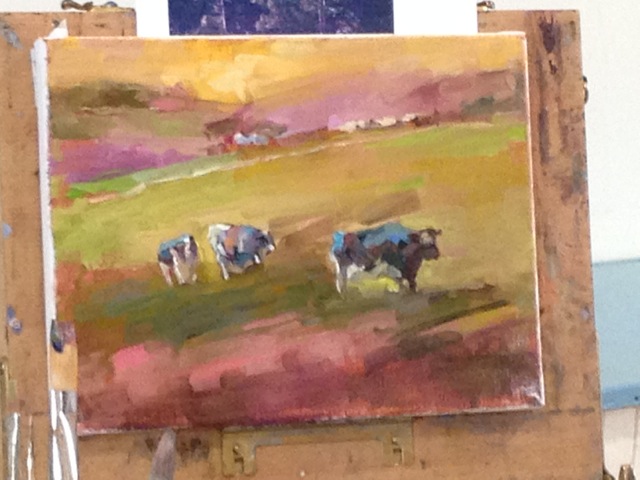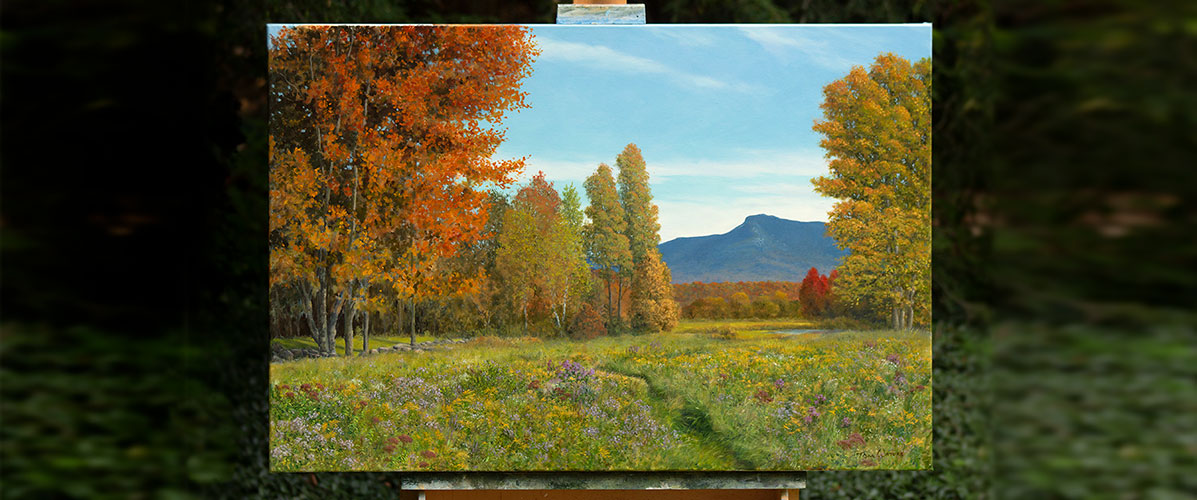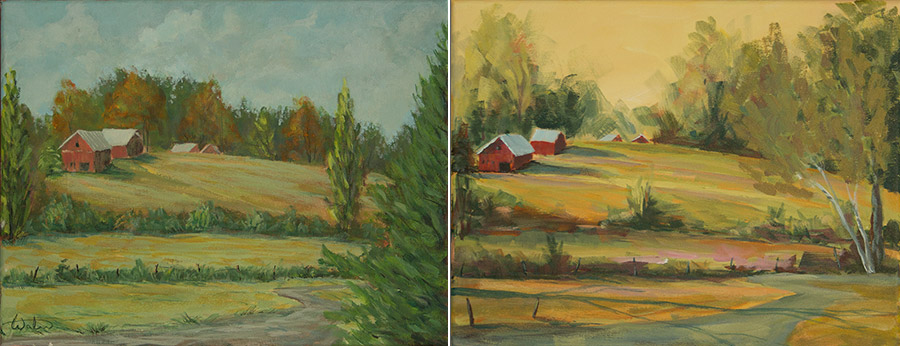Last Saturday I attended a 4 hour workshop by artist Aline Ordman a really wonderful landscape painter (website here) and we were instructed to bring something to paint (photos mostly, since we were confined indoors due to weather). So I took my most recent painting, Waitsfield Farm, because I was not fully satisfied with how it turned out. My hope was to re-paint the same landscape with what I hoped to learn and see if it came out better/
Aline gave a 1-hour demo in which she painted a quick landscape and provided commentary on what she was doing and why. Here is the painting she completed (in oils) in just 1 hour

Here is what I learned from her, before I get to my own efforts:
Follow the 4 “S”s. Squint, Simplify, Stand Back, Stop.
- Squint to see your value shapes and big color areas.
- Simplify your subject to only what is necessary.
- Stand back, often. Keep stepping back to look at your work in progress. You need that moment to see it in new light and take a breather.
- Stop. Know when you are done! Don’t keep tinkering. (I wrote a blog post about this some time ago).
Her approach to putting paint on the canvas is: 1-stroke, reload. 1-stroke, reload. Repeat. This way she keeps her colors clean, wiping her brush not necessarily after every stroke but very often.
Use a BIG brush and put down BIG swaths of color. She teaches that if you want to loosen up and get more freedom in your brush strokes, you need to use your biggest brushes. Start with big swaths of color, no need for a lot of color variation as you start, that can be added later, but get that canvas covered using a big brush so you can’t be tempted to get picky with detail.
And, to her painting is more like sculpting. She creates shapes, especially smaller shapes like the cows in the demo painting above, by sculpting the negative shape around the cows. She didn’t paint the cows so much as put down color and them paint the space (background) around the cows to form the cows. It really works for her.
Something else you notice in her work. She does not like blue skies. She feels its to limiting. She likes to see nicely colored skies right away with those first brush strokes which frees her to be more creative with color in the rest of the painting.
So with all that in mind, I took my painting and set about right from the start to work outside my comfort zone and try again. Here is the original painting I was about to paint again, only differently.

Out came the big brush, and on went the yellow sky. For the first 45 minutes or so I was doing pretty well. I blocked in the major areas, using what I thought were some good colors, and then….
Hit a wall.
Luckily this whole time Aline was making the rounds, helping people, answering questions, making suggestions. When she arrive back at my station she looked at what I had, and listened to my dilemma, and asked if it was OK to put some paint on my canvas. “Sure” I was all for getting some professional help. She mixed up some alizarin crimson and white, maybe just a touch of yellow, and dropped that pinkish-red right on my canvas. The red of the barn, she explained, had to be balanced out, it couldn’t be the only red in the painting, and by introducing this seemingly incoherent color she was freeing me to dip into other colors I hadn’t considered. When I looked at what I had done, it had the same overall green shades and lifeless quality I set out to try and liven up in my first painting. By dropping that pink in there she opened my eyes to seeing more opportunity to liven the whole thing up with color!
So off I went, adding in some reds, oranges, more blue. It gave me a new perspective.
About half an hour later on one of her rounds she caught me dithering with a small brush messing with detail. “Put away the 1-hair” she said, referring to any small brush as a “1-hair” used to labor over small, essentially meaningless, details. So I grabbed a bigger brush and a little more advice and went back at it.
In the end I could have used another 30 – 60 minutes to complete the repainting, but after 2 hours it was time for a group critique. Aline went around the room and critiqued every single painting, finding what was good, offering gentle suggestions on what else to try or work on. It is a skill to critique others work and find things to compliment in a wide range of skills and approaches, and she left everyone feeling good about what they had done and what they could improve.
Here is how the second attempt came out.

Whether you like the original or the second one better does not really matter so much, what matters is I learned new ways of approaching the canvas, applying paint, thinking about the composition, and using my tools. I think the 2nd one has more energy. I like the fuller range of colors, and I like that many areas of the painting feel more loose and free.
So I would recommend taking opportunities to attend workshops like this to get new perspectives. I know not every instructor will be your cup of tea, but its likely to get you thinking differently and trying new things. Aline will be returning in September, and I think I’ll make it point to be there.
Happy painting!


This is an awesome post my friend, thanks for writing it. Something I was wondering was if you were able to use acrylics or if you did the repainting in oils, since she was an oil painter, just wondering. I have yet to have the opportunity to attend a workshop but I’ve thought about it many times before – just need to find the right time and opportunity, and this post helped solidify my beliefs in it. You did some great work and really loosened up. Looking forward to your future paintings! Keep it up!
The second effort is definitely superior. While there isn’t a thing in the world wrong with the first one, the new one reaches out, grabs you by both sides of the face and says “Look at me and be enthralled!” Bright and bold, it is a painting I’d be proud to hang!
Thank you Brandon. Yes I did it in acrylic. I checked first and I get the impression it is not uncommon for workshops in oils to allow people to use other mediums. But you should check first. Most of these artists work or have worked in multiple mediums. And I am still hoping to do a workshop with Carolyn Walton sometime this year.
Thank you Jim. Its hard to break out of habits, but I am still searching for my style so trying different things is fun. Stay posted as tonight or tomorrow I will be posting about a painting I just finished that is completely different from anything I’ve done before. There is a story to it, but I can’t reveal that until later….